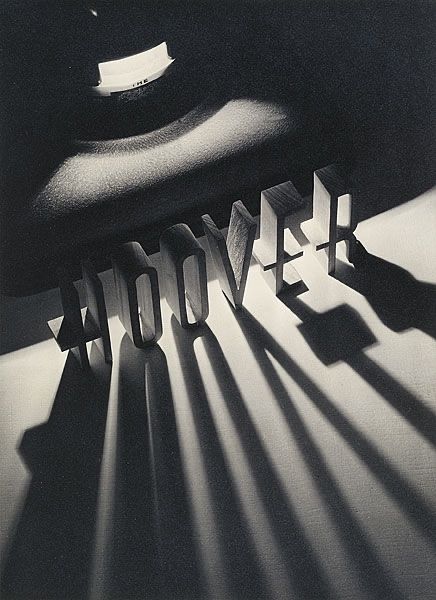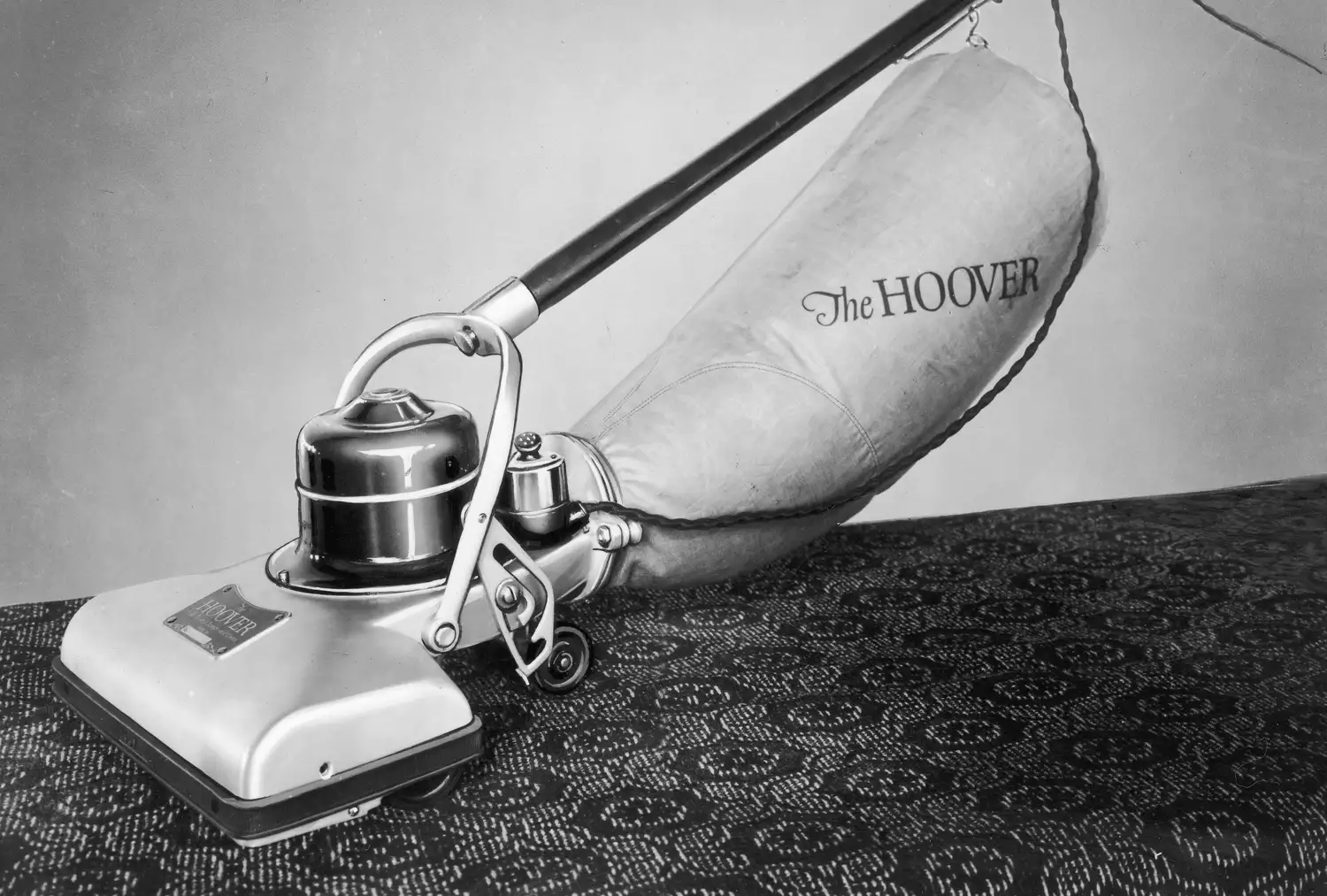- Early Hoover Designs: Before Henry Dreyfuss’s involvement, Hoover vacuum cleaners were functional but lacked aesthetic appeal, featuring a black motor and aluminum base design.
- Henry Dreyfuss’s Vision: Dreyfuss, an influential industrial designer, aimed to create products that were both functional and visually pleasing, focusing on user experience and ergonomics.
- The Hedlite Introduction (1932): Hoover introduced the “Hedlite” feature, a headlamp to illuminate the floor, but the design was still awkward and lacked modern appeal.
- Hoover Model 150 (1936): Dreyfuss completely redesigned the vacuum cleaner, concealing the mechanical components with a streamlined Bakelite shell, making it more attractive and user-friendly.
- Streamlined Design: The Model 150 featured a tear-drop shape influenced by the “streamlining” design trend of the 1930s, reflecting speed, efficiency, and modernity.
When we think about household products standing the test of time, few compare to Hoover vacuum cleaners. Much of Hoover’s success in the 20th century can be attributed to its collaboration with one of the most influential industrial designers of the era, Henry Dreyfuss.

Hoover Model 150
The Early Hoover Years: Functional, Uninspiring
Before Henry Dreyfuss entered the scene, Hoover vacuum cleaners were functional but lacked aesthetic appeal. Hoover’s design philosophy was driven by functionality and simplicity. Early models, like the Hoover 425, featured a black motor and an aluminum base—a combination unchanged for over two decades.
At the time, most household appliances were built with utility in mind. Design innovation was absent, with little consideration for visual integration into the modern home.
As consumer tastes evolved and home appliances became more widespread, demand grew for products performing well while looking modern and stylish.
Henry Dreyfuss: The Industrial Design Visionary
Henry Dreyfuss was already making waves as an up-and-coming industrial designer when he joined forces with Hoover in the early 1930s. Known for his human-centered design approach, Dreyfuss believed products should be functional, ergonomically sound, and visually pleasing. His design philosophy emphasized the user experience, revolutionary for the time.
In 1932, Hoover introduced the “Hedlite” feature—a headlamp illuminating the floor ahead of the vacuum cleaner, becoming standard in Models 750 and 900. While innovative, the “Hedlite” design still lacked aesthetic refinement, showing Hoover needed a fresh perspective to modernize its product line.

Henry Dreyfuss
The Game-Changing Hoover Model 150: A Design Revolution
In 1936, Henry Dreyfuss introduced the Model 150, a design changed Hoover’s trajectory and set new standards for home appliances.
1. Streamlined Aesthetics and Functionality
For the first time in Hoover’s history, mechanical workings were concealed under a Bakelite shell. This streamlined cover was visually appealing and easier to clean—perfect for the modern household.
Bakelite, an early plastic, allowed smoother shapes, easier to mold into intricate designs. The result? A vacuum cleaner durable and stylish.
The Model 150’s tear-drop shape followed the popular “streamlining” design trend of the 1930s, inspired by advances in aerodynamics and automobile design. This was a deliberate choice by Dreyfuss to reflect speed, efficiency, and modernity—qualities consumers associated with innovation during the machine age.
2. Integrated Headlamp for Convenience
Dreyfuss’s redesign fully integrated the Hedlite into the Model 150’s body, creating a seamless appearance. The headlamp wasn’t just an add-on but an integral part of the vacuum’s form.
Its purpose was to illuminate cleaning areas, especially in dimly lit spaces—a feature resonating with households in the 1930s, many of which had limited access to bright electric lighting.
The seamless incorporation of the headlamp, along with the sleek base and enclosed motor, made the Model 150 stand out in a market dominated by utilitarian designs.
3. Ergonomics and User Experience
Another key innovation of the Model 150 was its improved ergonomics. Dreyfuss’s human-centered design principles were evident in how the vacuum was easier to maneuver.
The handle was shaped to be comfortable, the weight distribution balanced to reduce user strain, and the cleaner was easier to maintain. These features were practical while enhancing the user experience—another reason why the Model 150 became a bestseller.

Hoover Model 150 Ad
The Impact on the Market: Hoover’s Rise to Dominance
The release of the Model 150 in 1936 was a significant milestone for Hoover. The vacuum cleaner was a household tool; it became a status symbol for modernity and innovation. Sales skyrocketed, elevating Hoover’s reputation as a leader in home appliances.
Dreyfuss’s redesign impacted the appliance industry. By showing aesthetics and functionality could coexist, Dreyfuss influenced manufacturers to rethink their approach to product design. The idea appliances should be beautiful as well as functional became a guiding principle for many companies in the following decades.
Industrial Design in the 1930s: A Broader Perspective
To fully appreciate Dreyfuss’s work with Hoover, it’s important to understand the broader context of industrial design during the 1930s. This was the era of the Great Depression, with consumer confidence low. However, demand remained for products symbolizing hope, progress, and efficiency.
The streamlining movement, which heavily influenced Dreyfuss, was about creating products feeling forward-thinking, even in tough economic times.
This design language was used in everything from cars to radios to vacuum cleaners, representing a belief in technology as a solution to the world’s problems.
Dreyfuss was a key figure in this movement, alongside other designers like Raymond Loewy and Norman Bel Geddes.
Each of these designers contributed to the growing importance of industrial design in American manufacturing, and their work paved the way for the sleek, user-friendly products defining consumerism today.
How Dreyfuss’s Design Philosophy Continues to Influence Hoover
The Model 150 wasn’t a one-time success for Hoover—it set the tone for future designs. Every vacuum cleaner Hoover produced after 1936 incorporated streamlined design principles and user-focused functionality Dreyfuss pioneered. His influence was so strong his design language became synonymous with the Hoover brand.
This trend continued with the 1957 Hoover Convertible, Dreyfuss’s final design for the company. The Convertible refined the aesthetics and usability of Hoover vacuums, incorporating ergonomic features while maintaining the sleek, modern look Dreyfuss introduced two decades earlier.

The Lasting Legacy of Henry Dreyfuss and the Model 150
Henry Dreyfuss remains one of the most influential industrial designers of the 20th century. His work with Hoover, particularly the Model 150, exemplifies his ability to transform everyday objects into iconic symbols of modernity.
The Model 150 represented a product capturing the spirit of the 1930s, an era marked by technological innovation and progress.
Hoover’s collaboration with Dreyfuss elevated the brand while demonstrating design’s power to influence consumer behavior. The Model 150’s blend of form and function resonated with households across America, proving thoughtful design could make a product indispensable in the home.
Conclusion: The Timeless Appeal of Thoughtful Design
The story of Henry Dreyfuss and the Hoover Model 150 is a powerful reminder of how thoughtful, user-focused design transforms a product from ordinary to extraordinary. Dreyfuss’s attention to detail, understanding of ergonomics, and ability to create visually appealing designs set new standards for home appliances in the 20th century.
The Hoover Model 150 remains an iconic piece of industrial design history—a symbol of the innovative spirit of the 1930s and a testament to Dreyfuss’s design philosophy.
Key Takeaways
- Dreyfuss Revolutionized Hoover’s Design: Henry Dreyfuss transformed Hoover vacuums from purely functional machines into aesthetically pleasing, streamlined products with his 1936 redesign of the Model 150.
- Introduction of Bakelite Shell: The Model 150 featured a teardrop-shaped Bakelite shell, concealing mechanical parts, enhancing durability, and introducing a sleek, modern appearance.
- Streamlined Aesthetics for Consumer Appeal: Dreyfuss’s design embraced the “streamlining” trend of the 1930s, which symbolized speed, efficiency, and modernity, making the vacuum cleaner more attractive to consumers.
- Enhanced Usability: The ergonomic improvements, including a more comfortable handle and better weight distribution, made the Model 150 easier and more comfortable to use.
- Market Success: The Model 150 played a key role in elevating Hoover’s reputation, positioning it as a leader in the home appliance market.
- Long-Lasting Design Influence: Dreyfuss’s design philosophy, focusing on form and function, continued to influence Hoover’s products for decades, including the 1957 Hoover Convertible.
- Legacy of Innovation: The Hoover Model 150 remains a symbol of how innovative design can elevate everyday household items, setting new standards for functionality and aesthetics in appliances.




































